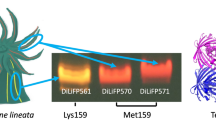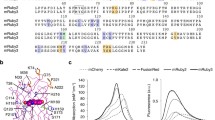Abstract
The marine environment is a rich reservoir of diverse biological entities, many of which possess unique properties that are of immense value to biotechnological applications. One such example is the red fluorescent protein derived from the coral Discosoma sp. This protein, encoded by the DsRed gene, has been the subject of extensive research due to its potential applications in various fields. In the study, a variant of the red fluorescent protein was generated through random mutagenesis using the DsRed2 gene as a template. The process employed error-prone PCR (epPCR) to introduce random mutations, leading to the isolation of twelve gene variants. Among these, one variant stood out due to its unique spectral properties, exhibiting dual fluorescence emission at both 480 nm (green) and 550 nm (red). This novel variant was expressed in both Escherichia coli and zebrafish (Danio rerio) muscle, confirming the dual fluorescence emission in both model systems. One of the immediate applications of this novel protein variant is in ornamental aquaculture. The dual fluorescence can serve as a unique marker or trait, enhancing the aesthetic appeal of aquatic species in ornamental settings.







Similar content being viewed by others
Availability of Data and Material
The data and material used in this study are available upon request from the authors.
References
Adam V, Lelimousin M, Boehme S, Desfonds G, Nienhaus K, Field MJ, Bourgeois D (2008) Structural characterization of IrisFP, an optical highlighter undergoing multiple photo-induced transformations. Proc Natl Acad Sci 105:18343–18348
Andresen M, Stiel AC, Trowitzsch S, Weber G, Eggeling C, Wahl MC, Jakobs S (2007) Structural basis for reversible photoswitching in Dronpa. Proc Natl Acad Sci 104:13005–13009
Bajar BT, Wang ES, Lam AJ, Kim BB, Jacobs CL, Howe ES, Chu J (2016) Improving brightness and photostability of green and red fluorescent proteins for live cell imaging and FRET reporting. Sci Rep 6:20889.
Baird GS, Zacharias DA, Tsien RY (2000) Biochemistry, mutagenesis, and oligomerization of DsRed, a red fluorescent protein from coral. Proc Natl Acad Sci 97:11984–11989.
Bansal L, Nelson R, Yang E, Jayaraman A, Hahn J (2013) Experimental design of systems involving multiple fluorescent protein reporters. Chem Eng Sci 101:191–198
Bevis BJ, Glick BS (2002) Rapidly maturing variants of the Discosoma red fluorescent protein (DsRed). Nat Biotechnol 20:83–87
Campbell BC, Nabel EM, Murdock MH, Lao-Peregrin C, Tsoulfas P, Blackmore MG, Petsko GA (2020) mGreenLantern: a bright monomeric fluorescent protein with rapid expression and cell filling properties for neuronal imaging. Proc Natl Acad Sci 117:30710–30721
Chalfie M, Tu Y, Euskirchen G, Ward WW, Prasher DC (1994) Green fluorescent protein as a marker for gene expression. Science 263:802–805
Choe CP, Choi SY, Kee Y, Kim MJ, Kim SH, Lee Y, Ro H (2021) Transgenic fluorescent zebrafish lines that have revolutionized biomedical research. Lab Anim Res 37:1–29
Chudakov DM, Matz MV, Lukyanov S, Lukyanov KA (2010) Fluorescent proteins and their applications in imaging living cells and tissues. Physiol Rev 90:1103–1163
Day RN, Davidson MW (2009) The fluorescent protein palette: tools for cellular imaging. Chem Soc Rev 38:2887–2921
Duwé S, Dedecker P (2019) Optimizing the fluorescent protein toolbox and its use. Curr Opin Biotech 58:183–191
Eli P, Chakrabartty A (2006) Variants of DsRed fluorescent protein: development of a copper sensor. Protein Sci 15:2442–2447
Figueiredo MA, Lanes CFC, Almeida DV, Marins LF (2007) Improving the production of transgenic fish germlines: in vivo evaluation of mosaicism in zebrafish (Danio rerio) using a green fluorescent protein (GFP) and growth hormone cDNA transgene co-injection strategy. Genet Mol Biol 30:31–36
Figueiredo MA, Mareco EA, Silva MDP, Marins LF (2012) Muscle-specific growth hormone receptor (GHR) overexpression induces hyperplasia but not hypertrophy in transgenic zebrafish. Transgenic Res 21:457–469
Garcia-Parajo MF, Koopman M, Van Dijk EM, HP, Subramaniam V, Van Hulst NF (2001) The nature of fluorescence emission in the red fluorescent protein DsRed, revealed by single-molecule detection. Proc Natl Acad Sci 98:14392–14397
Habuchi S, Cotlet M, Gensch T, Bednarz T, Haber-Pohlmeier S, Rozenski J, Hofkens J (2005) Evidence for the isomerization and decarboxylation in the photoconversion of the red fluorescent protein DsRed. J Am Chem Soc 127:8977–8984
Hanson GT, McAnaney TB, Park ES, Rendell ME, Yarbrough DK, Chu S, Remington SJ (2002) Green fluorescent protein variants as ratiometric dual emission pH sensors. 1. Struct Charact Prelim Appl Biochem 41:15477–15488
Jach G, Binot E, Frings S, Luxa K, Schell J (2001) Use of red fluorescent protein from Discosoma sp. (dsRED) as a reporter for plant gene expression. Plant J 28:483–491
Jones AM, Ehrhardt DW, Frommer WB (2012) A never ending race for new and improved fluorescent proteins. BMC Biol 10:1–3
Krueger TD, Tang L, Zhu L, Breen IL, Wachter RM, Fang C (2020) Dual illumination enhances transformation of an engineered green-to-red photoconvertible fluorescent protein. Angew Chem 132:1661–1669
Lambert TJ (2019) FPbase: a community-editable fluorescent protein database. Nat Methods 16:277–278
Macel ML, Ristoratore F, Locascio A, Spagnuolo A, Sordino P, D’Aniello S (2020) Sea as a color palette: the ecology and evolution of fluorescence. Zool Lett 6:9.
Matz MV, Fradkov AF, Labas YA, Savitsky AP, Zaraisky AG, Markelov ML, Lukyanov SA (1999) Fluorescent proteins from nonbioluminescent Anthozoa species. Nat Biotechnol 17:969–973
McAnaney TB, Shi X, Abbyad P, Jung H, Remington SJ, Boxer SG (2005) Green fluorescent protein variants as ratiometric dual emission pH sensors. 3. Temp Depend Proton Trans Biochem 44:8701–8711
Mikkelsen L, Sarrocco S, Lübeck M, Jensen DF (2003) Expression of the red fluorescent protein DsRed-Express in filamentous ascomycete fungi. FEMS Microbiol Lett 223:135–139
Nagai T, Ibata K, Park ES, Kubota M, Mikoshiba K, Miyawaki A (2002) A variant of yellow fluorescent protein with fast and efficient maturation for cell-biological applications. Nat Biotechnol 20:87–90
Nienhaus K, Nienhaus GU (2014) Fluorescent proteins for live-cell imaging with super-resolution. Chem Soc Rev 43:1088–1106
Prasher DC, Eckenrode VK, Ward WW, Prendergast FG, Cormier MJ (1992) Primary structure of the Aequorea victoria green-fluorescent protein. Gene 111:229–233
Prescott M, Battad JM, Wilmann PG, Rossjohn J, Devenish RJ (2006) Recent advances in all-protein chromophore technology. Biotechnol Annu Rev 12:31–66
Quan J, Tian J (2011) Circular polymerase extension cloning for high-throughput cloning of complex and combinatorial DNA libraries. Nat Protoc 6:242–251
Shaner NC, Lin MZ, McKeown MR, Steinbach PA, Hazelwood KL, Davidson MW, Tsien RY (2008) Improving the photostability of bright monomeric orange and red fluorescent proteins. Nat Methods 5:545–551
Shcherbakova DM, Verkhusha VV (2014) Chromophore chemistry of fluorescent proteins controlled by light. Curr Opin Chem Biol 20:60–68
Shen Y, Lai T, Campbell RE (2015) Red fluorescent proteins (RFPs) and RFP-based biosensors for neuronal imaging applications. Neurophotonics 2:031203–031203
Sigwart JD, Blasiak R, Jaspars M, Jouffray JB, Tasdemir D (2021) Unlocking the potential of marine biodiscovery. Nat Prod Rep 38:1235–1242
Stepanenko OV, Stepanenko OV, Kuznetsova IM, Verkhusha VV, Turoverov KK (2013) Beta-barrel scaffold of fluorescent proteins: folding, stability and role in chromophore formation. Int Rev Cell Mol Biol 302:221–278
Subach FV, Verkhusha VV (2012) Chromophore transformations in red fluorescent proteins. Chem Rev 112:4308–4327
Tao A, Zhang R, Yuan J (2020) Characterization of photophysical properties of photoactivatable fluorescent proteins for super-resolution microscopy. J Phys Chem B 124:1892–1897
Terskikh A, Fradkov A, Ermakova G, Zaraisky A, Tan P, Kajava AV, Siebert P (2000) “Fluorescent timer”: protein that changes color with time. Science 290:1585–1588
Tubbs JL, Tainer JA, Getzoff ED (2005) Crystallographic structures of Discosoma red fluorescent protein with immature and mature chromophores: linking peptide bond trans− cis isomerization and acylimine formation in chromophore maturation. Biochemistry 44:9833–9840
Verkhusha VV, Otsuna H, Awasaki T, Oda H, Tsukita S, Ito K (2001) An enhanced mutant of red fluorescent protein DsRed for double labeling and developmental timer of neural fiber bundle formation. J Biol Chem 276:29621–29624
Wan H, He J, Ju B, Yan T, Lam TJ, Gong Z (2002) Generation of two-color transgenic zebrafish using the green and red fluorescent protein reporter genes gfp and rfp. Mar Biotechnol 4:146–154
Wiedenmann J, Ivanchenko S, Oswald F, Schmitt F, Röcker C, Salih A, Nienhaus GU (2004) EosFP, a fluorescent marker protein with UV-inducible green-to-red fluorescence conversion. Proc Natl Acad Sci 101:15905–15910. https://doi.org/10.1073/pnas.0403668101
Yarbrough D, Wachter RM, Kallio K, Matz MV, Remington SJ (2001) Refined crystal structure of DsRed, a red fluorescent protein from coral, at 2.0-Å resolution. Proc Natl Acad Sci 98:462–467
Acknowledgements
We would like to express our gratitude to the Molecular Biology Laboratory at the Federal University of Rio Grande (FURG) and the Molecular Microbiology and Proteins Laboratory (LaMMP) at the Federal University of Rio de Janeiro (UFRJ) for their assistance, resources, and expertise, which were instrumental in the successful completion of our research.
Funding
This study was funded by CNPq (MCTI/CNPQ Call No. 454689/2014–4) and by CAPES, which provided the master’s scholarship. L.F. Marins is a research fellow from CNPq (Proc. no. 307304/2022-1).
Author information
Authors and Affiliations
Contributions
All authors contributed to the study conception and design. Material preparation, data collection, writing of the main manuscript text, and analysis were performed by N. O.-H. and D.V. A. All authors reviewed the manuscript.
Corresponding authors
Ethics declarations
Ethics Approval and Consent to Participate
All experimental procedures were conducted in accordance with the Ethics for Animal Use Committee from the Federal University of Rio Grande, where this study was carried out (Protocol Pq024/2015). All participants gave their consent to participate.
Conflict of Interest
The authors declare no competing interests.
Additional information
Publisher's Note
Springer Nature remains neutral with regard to jurisdictional claims in published maps and institutional affiliations.
Supplementary Information
Below is the link to the electronic supplementary material.
Rights and permissions
Springer Nature or its licensor (e.g. a society or other partner) holds exclusive rights to this article under a publishing agreement with the author(s) or other rightsholder(s); author self-archiving of the accepted manuscript version of this article is solely governed by the terms of such publishing agreement and applicable law.
About this article
Cite this article
Ossa-Hernández, N., Marins, L.F., Almeida, R.V. et al. Red Fluorescent Protein Variant with a Dual-Peak Emission of Fluorescence. Mar Biotechnol 25, 1099–1109 (2023). https://doi.org/10.1007/s10126-023-10262-z
Received:
Accepted:
Published:
Issue Date:
DOI: https://doi.org/10.1007/s10126-023-10262-z




